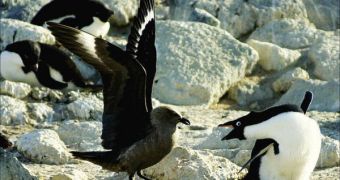Since the dawn of mankind, we have admired the wonderful colors of birds' plumages, and watched in awe how the peacock, for example, shows its beautiful feathers to attract mates. But a new scientific study comes to show that a large percentage of birds everywhere deals with a very serious problem – infecting parasites that essentially eat the feathers. The degrading bacteria is a nuisance to get rid of, and reappears shortly after it has been destroyed. It makes feathers look dull, and takes the shine off the plumages, with potentially devastating consequences for a large number of species.
A new investigation revealed that 99% of all Eastern bluebirds surveyed in Virginia, the United States, were infected with various feather-eating parasites, which adversely affected their quality of life, as well as their ability to mate and give birth to offspring. The bugs have a considerable influence on the way the birds look and feel, and can even make them sick with relative ease, the BBC News informs. “Feather-degrading bacteria are relatively new to ornithologists. The first report of their occurrence on wild birds was published only ten years ago,” Duke University expert Alex Gunderson says.
The basic mechanism through which these bacterium species destroy the birds is by hydrolyzing the protein beta-keratin, which makes about 90 percent of the total mass of a feather. This leaves the feathers “dull” and unable to perform at the highest standards. Their color also degrades, which means that less partners are attracted to infested birds. And if all of them are infested, then the future of the entire species is at risk, the scientists say.
“This is some of the best evidence that bacteria are active on the feathers of live birds. The evidence is correlational, so there is a great deal more work that needs to be done to verify it. But it does suggest that feather-degrading bacteria could be an important force influencing the ecology and evolution of birds,” Gunderson adds. Investigations, however, reveal that the bacteria attack species of birds differently. In their research on Eastern bluebirds (Sialia sialis) living in Virginia, they noticed that females were affected more than males. Details appear in the latest issue of the Journal of Avian Biology.
“I was surprised that the relationship with feather-degrading bacteria was different for males and females. It is possible that, because males and females differ somewhat in where they spend their time, they could acquire different species of bacteria that have different effects. It is also possible that physiological differences between males and females result in different effects of bacteria. This is complete speculation and at present we do not know the answer to this question,” the expert says.
“If bacteria detrimentally influence feather coloration, they may place selective pressure on birds to evolve defenses against them. There is evidence that certain avian traits are defenses [sic.] against feather-degrading bacteria. For instance, we know that feathers colored by melanin pigments are resistant to bacterial degradation, and that the preen oil that birds apply to their plumage inhibits the growth of some feather-degrading bacteria. In general, an understanding of the influence of feather-degrading bacteria on birds could, to some degree, help explain the evolution of these and other avian traits,” Gunderson concludes.

 14 DAY TRIAL //
14 DAY TRIAL //